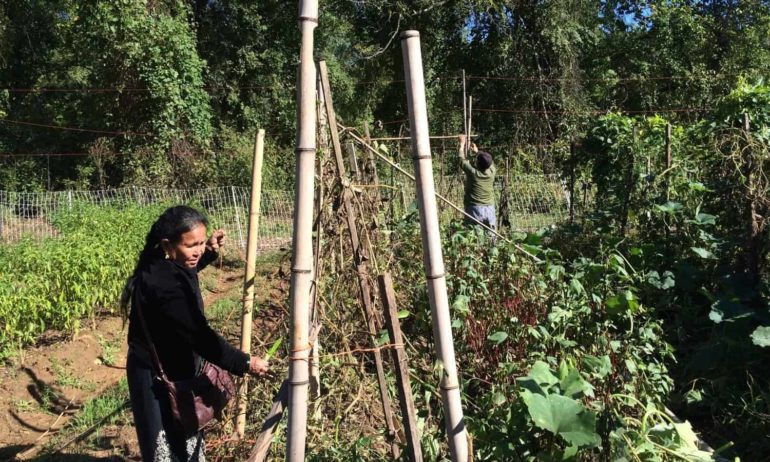The International Rescue Committee (IRC) is a non-profit organization helping refugees rebuild their lives and livelihoods. Every year, the IRC works with thousands of displaced people, whose lives have been shattered by war and oppression, to find new homes, jobs, healthcare and educational opportunities in 24 cities in the United States. The IRC New Roots program provides newly resettled refugees with opportunities to grow food in community gardens and on urban farms. New Roots assists resettled refugees in finding land, supports participants to hone their food production skills, and is building marketing and food access opportunities in several communities around the country.
Aley Kent, an IRC National Technical Advisor for Food Security and Agriculture, and Elizabeth Moore, Farm Manager of the New Roots Farm in Charlottesville, Virginia, spoke with Food Tank about the important role of food production in the refugee resettlement process.
Food Tank (FT): How did the New Roots program begin?
Aley Kent (AK): Around 2005, a staff member working in the San Diego office was talking to some Somali women about options for them in the U.S. A lot of them did not have your typical job readiness skills that most employers look for in this country. However, the women were saying, “We want to farm! Is there a place that we can grow food? We want our kids to understand our roots. Can you help us do that? Maybe we can make money that way!” So, the idea of New Roots was born.
FT: How is New Roots an important piece of the resettlement process?
AK: There are many reasons that people want to grow food. Not the least of these, for many newly resettled refugees, are around mental health and feeling grounded and connected back to the land. Especially for people who come from agrarian societies – where they have grown up literally connected to the land, eating off that land – it is their whole life. For someone from South Sudan, the Congo, Burma, or Bhutan who’s always farmed, the act of gardening helps to re-establish a sense of place.
We talk a lot at IRC about community integration. In many cases, we’re working with one member of the household to find a job, and for the other members of the household there can be a lot of isolation. Typically it’s elder women who have never had a formal education, who have farmed their whole lives and just don’t feel comfortable getting into the mainstream work world here or can’t for some reason. I think (New Roots) provides an incredibly important outlet – in gardens, at open-air farm stands and markets – for forming connections and feeling “at home.”
But people also want to grow food to cut down on their grocery bills, to have access to the types of foods they can’t necessarily buy or specialty foods they want to cook with. And, in all of these settings, there are people who want to re-engage in trying to sell their surpluses; to have something they love to do contribute to their livelihood.
FT: Can you give a specific example of how the New Roots program has affected refugees?
AK: Charlottesville is a good example: They piloted a farmers market on an empty grassy area near a housing complex. People were playing soccer, hanging out all day and spending their hard earned money on fruits and vegetables. Even last summer, before the market was able to accept Supplemental Nutrition Assistance Program (SNAP) benefits, it was immediately popular with the community.
Elizabeth Moore (EM): Charlottesville’s micro producer program has two objectives. One is for farmers to have some secondary income. The second is to increase access to culturally relevant produce among our refugee population. So, we now have a market in the neighborhoods (where refugees live). We take the food to the market, we sell it, and then each farmer receives the direct proportion of what they contributed to what was sold.
Most of the farmers primarily want to be farming here because they want this food for their homes. But some of them are more entrepreneurial and are excited about the idea of providing to the wider community, making money. Dhan and Tek, for example, have been making independent sales of peppers, eggplants, and bitter melons to one of the Indian/Nepali markets.
FT: How does New Roots fit into the larger movement to create a more sustainable food system?
AK: New Roots has been doing a lot of work recently around building markets: farmers markets, CSAs, and food access points in communities.
Some IRC programs, depending on their local community, are more focused on livelihoods and economic development, and some are more focused on food access, health, and nutrition. Baltimore is a great example of a program that is focused on health outcomes. Here, New Roots is not only helping many refugee urban famers to boost their own production across three community gardens and seven backyard garden sites, but also is working with Real Food Farm in Baltimore that manages a mobile market truck. IRC helps identify locations in refugee-rich communities for the Real Food Farm mobile market to set up shop. At these sites, the Baltimore staff administer our Fresh Fund program that enables people to double their SNAP dollars spent at that market.
FT: How do you share knowledge of growing techniques across language and cultural divides?
EM: At the Charlottesville micro producer farm we have five languages, spoken by farmers from Bhutan, Nepal, Burma, Burundi, Iraq, and Afghanistan.
I think cultural sharing is one of the most exciting things: seeing friendships develop between people from different countries, sharing how they might both plant or be familiar with the same crops and cook them in different ways. Bu Lar, our Burmese farmer, and Indra, who’s from Bhutan, live near each other, and Bu Lar always gives Indra a ride. They’ve developed a really nice friendship, and neither of them speaks very much English at all.















